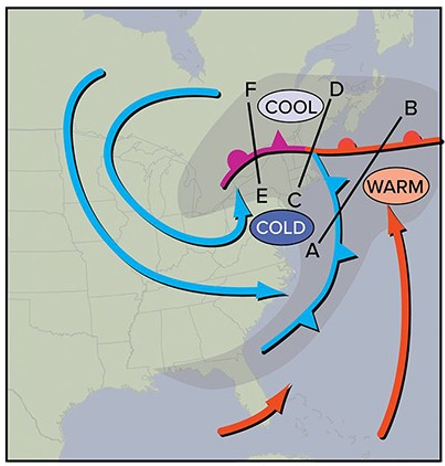Discuss and compare the forces that are responsible for creating surface and thermohaline circulation in the oceans. Include in your answer the ultimate source of energy that drives both circulation systems
What will be an ideal response?
Surface currents develop from friction between the ocean and the wind that blows across its surface. Only about 2% of the wind's energy is transferred to the ocean surface, so a 50-knot wind will create a 1-knot current. If there were no continents on Earth, the surface currents would generally follow the major wind belts of the world. In each hemisphere, therefore, a current would flow between 0 and 30 degrees latitude as a result of the trade winds, a second would flow between 30 and 60 degrees latitude as a result of the prevailing westerlies, and a third would flow between 60 and 90 degrees latitude as a result of the polar easterlies. In reality, ocean surface currents are driven by more than just the wind belts of the world. The distribution of continents on Earth is one factor that influences the nature and direction of flow of surface currents in each ocean basin. Most water involved in deep-ocean currents (thermohaline circulation) originates in high latitudes at the surface. In these regions, surface water becomes cold and its salinity increases as sea ice forms. When this surface water becomes dense enough, it sinks, initiating deep-ocean currents. Once this water sinks, it is removed from the physical processes that increased its density in the first place, so its temperature and salinity remain largely unchanged for the duration it spends in the deep ocean. As these surface water masses become dense and are sinking (downwelling) in high-latitude areas, deep- water masses are also rising to the surface (upwelling). Because the water temperature in high-latitude regions is the same at the surface as it is down below, the water column is isothermal, there is no thermocline or associated pycnocline, and upwelling and downwelling can easily occur.
You might also like to view...
In regard to the occlusion process, at which segment has warm air been lifted above the cooler and cold air?

A) F-E
B) D-C
C) B-A
The population growth curve is ____________ when a population encounters environmental resistance. Fill in the blank(s) with the appropriate word(s)
Geographer Derwent Whittlesey identified 11 main agricultural regions where divided by their importance to either developing or developed countries
Which agricultural region, that is important to the developing countries, covers the most area in the southern hemisphere? A) Grain B) Shifting cultivations C) Dairying D) Plantation E) Mediterranean
Evidence from Hawaii suggests that underwater landslides have been ________ than any known continental landslide. These are particularly concerning as they would likely generate ________.
A. slower; a mass extinction event B. smaller; a long-lasting earthquake C. larger; an enormous tsunami D. faster; abnormal surface waves